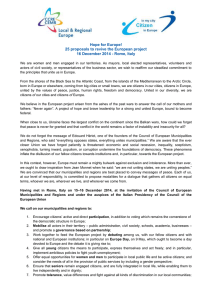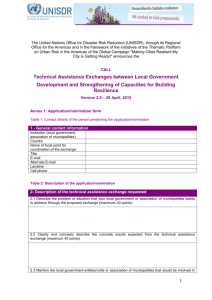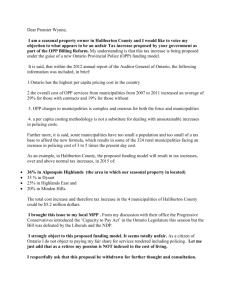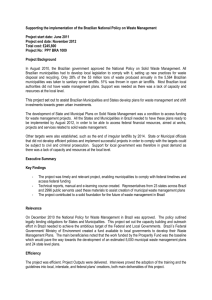Meeting the development goals in sanitation services in Brazil: 26
advertisement
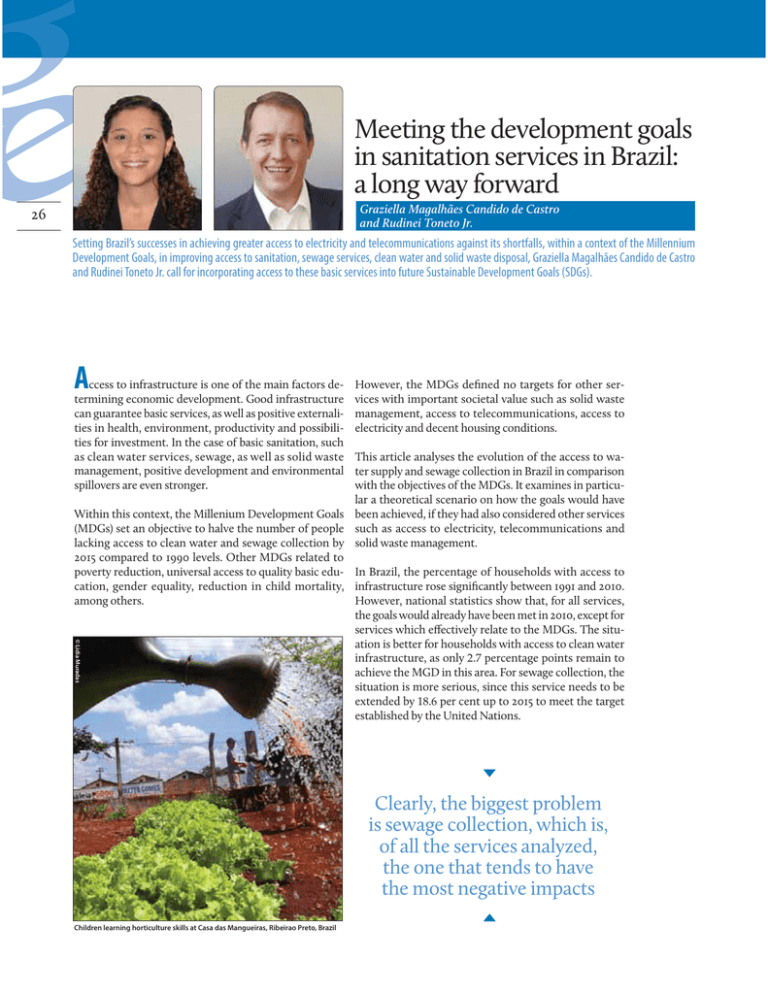
Meeting the development goals in sanitation services in Brazil: a long way forward Graziella Magalhães Candido de Castro and Rudinei Toneto Jr. 26 Setting Brazil’s successes in achieving greater access to electricity and telecommunications against its shortfalls, within a context of the Millennium Development Goals, in improving access to sanitation, sewage services, clean water and solid waste disposal, Graziella Magalhães Candido de Castro and Rudinei Toneto Jr. call for incorporating access to these basic services into future Sustainable Development Goals (SDGs). A ccess to infrastructure is one of the main factors determining economic development. Good infrastructure can guarantee basic services, as well as positive externalities in health, environment, productivity and possibilities for investment. In the case of basic sanitation, such as clean water services, sewage, as well as solid waste management, positive development and environmental spillovers are even stronger. However, the MDGs defined no targets for other services with important societal value such as solid waste management, access to telecommunications, access to electricity and decent housing conditions. © Lidia Muradas This article analyses the evolution of the access to water supply and sewage collection in Brazil in comparison with the objectives of the MDGs. It examines in particular a theoretical scenario on how the goals would have Within this context, the Millenium Development Goals been achieved, if they had also considered other services (MDGs) set an objective to halve the number of people such as access to electricity, telecommunications and lacking access to clean water and sewage collection by solid waste management. 2015 compared to 1990 levels. Other MDGs related to poverty reduction, universal access to quality basic edu- In Brazil, the percentage of households with access to cation, gender equality, reduction in child mortality, infrastructure rose significantly between 1991 and 2010. among others. However, national statistics show that, for all services, the goals would already have been met in 2010, except for services which effectively relate to the MDGs. The situation is better for households with access to clean water infrastructure, as only 2.7 percentage points remain to achieve the MGD in this area. For sewage collection, the situation is more serious, since this service needs to be extended by 18.6 per cent up to 2015 to meet the target established by the United Nations. Clearly, the biggest problem is sewage collection, which is, of all the services analyzed, the one that tends to have the most negative impacts Children learning horticulture skills at Casa das Mangueiras, Ribeirao Preto, Brazil for water access (77.4 per cent) as well as sewage collection (75 per cent). TABLE 1 Percentage of Brazilian households with access to infrastructure Service/Year Water Sewage Electricity Telephone Solid waste management 1991 70,7% 35,3% 86,9% 18,6% 63,9% 2010 82,7% 57,0% 97,8% 87,9% 87,4% % of MDG 85,4% 67,6% 93,4% 59,3% 81,9% Source: Developed by the authors based on demographic surveys from 1991 and 2010. While Brazil as a whole is near to attaining the goal on clean water access and has already attained the goals in other infrastructure services (except sewage collection), the growth is unequal and depends on the economic conditions and geographic areas of the country. As table 2 shows, the percentage of municipalities meeting the MDGs is higher in the southeastern and southern regions of the country. However, in the South, the percentage is still very low for access to water and sewage collection. The situation is more dire in the northern, northeastern and west-central regions, and the worst in the North, where fewer than 2 per cent of municipalities meet water and sewage collection goals. In the northeastern and centre-west regions, around 10 per cent of the municipalities have met the goals set by the United Nations, except for water supply in the northeastern region. It should be remembered that a high percentage of municipalities in all regions meet the goals, where they existed, for access to electricity, telephone coverage and solid waste management. The exception is solid waste management in the northern and northeastern region, where only half of the municipalities met the goal. TABLE 2 Percentage of municipalities meeting MDGs, per region Water Region North Northeast Southeast South Centre-west 1,7% 2,9% 38,5% 26,0% 9,0% Percentage of municipalities Sewage Electricity Telephone Solid waste management 1,0% 10,7% 66,1% 21,1% 9,5% 82,2% 99,6% 99,5% 99,9% 99,5% 75,8% 84,1% 98,3% 99,8% 100,0% 52,7% 52,0% 85,9% 87,2% 78,9% Source: Developed by the authors based on a census from 1991 and 2010. It is interesting to observe that the higher the rate of urbanization, the higher the relative number of municipalities that succeed in reaching MDGs for clean water access and sewage collection. In the municipalities with up to 10 per cent of households in rural areas, none met the target. On the other hand, in the group of municipalities with urbanization rates from 90 to 100 per cent , about 75 per cent have managed to halve their deficits Another question that merits attention is the number of municipalities meeting the goals in relation to their per-capita GDP in 2010. As expected, income has a strong relation to the level of access to infrastructure. The percentage of municipalities meeting the goals for clean water supply grows with income, but only for the first two scales of per capita GDP. For the subsequent levels, this percentage remains stable. It can also be seen that, among the poorest municipalities with per-capita income under USD 4,000, only 4.1 per cent managed to meet the goals set by the United Nations. This percentage grows to 29 per cent once income per capita rises to between USD 4,000 and USD 8,000 and reaches 49 per cent for municipalities with per-capita income above USD 8,000. Taking into account the percentage of municipalities reaching the goal for sewage collection, the positive relationship between per capita income and access to infrastructure is even clearer. At the first level of income per capita (less than USD 4,000), only 13 per cent of municipalities met the goal while, at the highest income level (above USD 20,000) this percentage reaches 71.4 per cent. As for reductions in the deficit of access to electricity and telephone services, the percentage of municipalities for all income levels is greater than 90 per cent , except for telephone access at the lowest income level where the rate is 85.9 per cent . Like the other services mentioned, solid waste management is very correlated to income. In the lowest level of per-capita income slightly more than half of the municipalities have reached the target for deficit reduction, for other income levels this percentage is higher than 85 per cent of the municipalities. It is therefore clear that even though Brazil is very close to meeting the goal for access to clean water and has already met the goals for access to electricity and telephone and solid waste management, a number of municipalities in Brazil have yet to achieve them. Clearly, the biggest problem is sewage collection, which is, of all the services analyzed, the one that tends to have the most negative impacts. Garbage is another serious problem: while collection has risen during the period analyzed, its destination continues to be open-air depots known as city dumps. In 2007, Brazil approved a national law for basic sanitation, which identifies a need to develop municipal plans for sanitation to achieve universal coverage. More recently, the country approved a national law for solid waste, which calls for the end of city dumps by 2014. These are essential objectives to combine development with sustainability. The high existing deficits in 27 28 At the same time as Brazil as a whole is on course to meet the goals at an aggregate level, various regions and municipalities could be sidelined in the development process once again reinforcing the strong regional and human inequalities that exist. A large part of the difficulty comes from the low investment capacity of the government as well as low incentives for private investors to reach the section of the population most affected by such deficits, whether due to the low expected profitability of investments or the low purchasing power by the population lacking such services. Many countries like Brazil still need to invest heavily to achieve the MDGs. Thus, given the positive impacts in terms of economic and social development as well as the relevance of environmental issues, Sustainable Development Goals (SDGs) should incorporate access to all public services, especially basic sanitation (clean water services, sewage, solid waste management), electricity and telecommunications Δ sanitation and solid waste services, the concentration of problems in low-income municipalities, lower urbanization rates, smaller population sizes and lower population densities contribute to amplifying the challenge of meeting the goals. About the authors Graziella Magalhães Candido de Castro and Rudinei Toneto Jr. are researchers in the Low Carbon Economy Center of the University of São Paulo in Ribeirão Preto, Brazil. Annexes TABLE 1 Percentage of municipalities reaching the goals, per State of Brazil Water State Rondônia Acre Amazonas Roraima Pará Amapá Tocantins Maranhão Piauí Ceará Rio Grande do Norte Paraíba Pernambuco Alagoas Sergipe Bahia Minas Gerais Espírito Santo Rio de Janeiro São Paulo Paraná Santa Catarina Rio Grande do Sul Mato Grosso do Sul Mato Grosso Goiás Distrito Federal 0,3% 0,0% 0,0% 1,6% 0,0% 0,0% 33,3% 2,5% 0,2% 2,9% 4,2% 3,4% 3,3% 0,6% 1,8% 15,5% 202,7% 2,4% 1,0% 52,0% 146,3% 45,7% 17,0% 1,3% 2,8% 6,0% 0,3% Sewage collection 0,0% 4,3% 8,3% 0,0% 12,5% 0,0% 0,0% 1,3% 0,0% 4,4% 16,1% 10,7% 27,0% 5,3% 5,4% 58,8% 464,9% 6,5% 3,1% 73,4% 119,4% 42,9% 12,9% 0,8% 0,3% 12,4% 0,3% Source: d0eveloped by the authors based on demographic surveys from 1991 and 2010. Electrification 7,7% 52,2% 283,3% 9,7% 1037,5% 8,6% 866,7% 170,9% 7,7% 130,9% 128,8% 96,1% 110,5% 56,7% 44,0% 424,7% 977,0% 16,1% 4,8% 78,3% 480,6% 310,0% 58,2% 8,1% 29,4% 96,8% 0,3% Telephone access 7,7% 43,5% 233,3% 6,5% 1000,0% 6,7% 822,2% 78,5% 5,0% 121,3% 128,8% 94,4% 106,6% 52,6% 44,0% 329,9% 944,6% 16,1% 4,9% 79,0% 479,1% 310,0% 58,2% 8,2% 29,4% 97,2% 0,3% Solid waste management 4,7% 34,8% 150,0% 8,1% 587,5% 6,7% 644,4% 45,6% 3,4% 64,0% 85,6% 51,1% 65,1% 29,8% 30,4% 222,7% 770,3% 11,3% 4,9% 75,1% 419,4% 282,9% 49,3% 4,5% 22,3% 86,2% 0,3% TABLE 2 TABLE 6 Percentage of municipalities meeting the goal of clean water access, by urbanization rate, in 2010 Urbanization rate up to 10% from 10% to 20% from 20% to 30% from 30% to 40% from 40% to 50% Target attained No Yes 100,0% 0,0% 100,0% 0,0% 97,2% 2,8% 98,4% 1,6% 97,9% 2,1% Percentage of municipalities meeting the electricity access goal, by per-capita GDP in 2010 GDP per capita (USD) up to 4,000 from 4,000 to 8,000 from 8,000 to 12,000 from 12,000 to 20,000 above 20,000 Target attained No Yes 2,5% 97,5% 0,4% 99,6% 0,5% 99,5% 1,3% 98,7% 2,9% 97,1% Source: developed by the authors based on demographic surveys from 1991-2010. Source: developed by the authors based on demographic surveys from 1991-2010. TABLE 3 TABLE 7 Percentage of municipalities meeting the goal for sewage by urbanization rate in 2010 Urbanization rate up to 10% from 10% to 20% from 20% to 30% from 30% to 40% from 40% to 50% from 50% to 60% from 60% to 70% from 70% to 80% from 80% to 90% from 90% to 100% Target attained No Yes 100,0% 0,0% 95,0% 5,0% 99,1% 0,9% 98,7% 1,3% 99,1% 0,9% 97,3% 2,7% 87,8% 12,2% 66,2% 33,8% 46,0% 54,0% 22,6% 77,4% Source: developed by the authors based on demographic surveys from 1991-2010. Percentage of municipalities reaching telephone access goals, by per-capita GDP in 2010 GDP per capita (USD) up to 4,000 1 from 4,000 to 8,000 from 8,000 to 12,000 from 12,000 to 20,000 above 20,000 Percentage of municipalities reaching the clean water access goal, based on GDP per capita in 2010 GDP per capita (USD) up to 4,000 from 4,000 to 8,000 from 8,000 to 12,000 from 12,000 to 20,000 above 20,000 Target attained No Yes 95,9% 4,1% 71,0% 29,0% 50,9% 49,1% 51,0% 49,0% 51,4% 48,6% Target attained No Yes 4,1% 85,9% 1,0% 99,0% 0,8% 99,2% 0,0% 100,0% 0,0% 100,0% Source: developed by the authors based on demographic surveys from 1991-2010. TABLE 8 Percentage of municipalities reaching trash colection goals, by per-capita GDP in 2010 GDP per capita (USD) TABLE 4 29 9 Up to 4,000 from 4,000 to 8,000 from 8,000 to 12,000 from 12,000 to 20,000 above 20,000 Target attained No Yes 43,9% 56,1% 14,0% 86,0% 6,6% 93,4% 3,9% 96,1% 8,6% 91,4% Source: developed by the authors based on demographic surveys from 1991-2010. Source: developed by the authors based on demographic surveys from 1991-2010. TABLE 5 Percentage of municipalities meeting the sewage collection goal, by per-capita GDP in 2010 GDP per capita (USD) Source: developed by the authors based on demographic surveys from 1991-2010. © Trata Brasil up to 4,000 from 4,000 to 8,000 from 8,000 to 12,000 from 12,000 to 20,000 above 20,000 Target attained No Yes 86,3% 13,7% 57,9% 42,1% 45,1% 54,9% 46,1% 53,9% 28,6% 71,4% Itajuibe community in Itaim Paulista, Sao Paulo, Brazil
